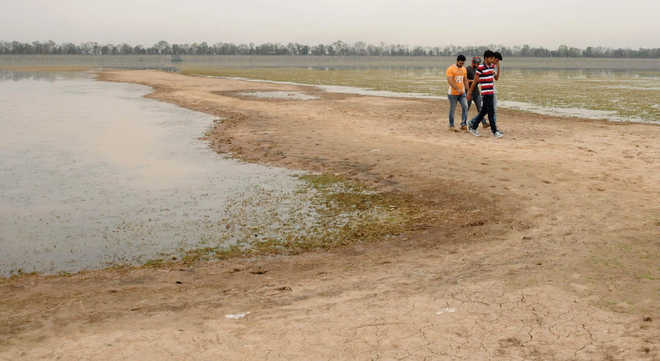
Visitors walk through a dry patch of Sukhna Lake as the water level has receded. File Photo
Sandeep Sinha
Paani da rang vekh ke, ankhiyan jo hanju rul de (Seeing the colour of water, tears roll down my eyes).
The lines sung by Chandigarh boy and actor Ayushmann Khurana in the Hindi film Vicky Donor sum up the condition of the city’s iconic Sukhna Lake. The water level in the lake has gone down to 1,152 ft, the lowest in the past five years, and the danger of the lake bed becoming visible with its cascading effect on adjoining flora and fauna is very much there.
The lake is central to the life of the city. It is a fitness centre, a beacon of environmental awareness and a window to the city’s cosmopolitan culture.
Predictably, UT Administrator VP Singh Badnore has called for steps to revive Sukhna. Mr Badnore had earlier called for seeking tips from Jaipur to tackle the stray dog menace in the tricity. He might as well look for some tips on water management from Jaipur.
Hailing from Rajasthan, the UT Administrator cannot underestimate the implications of a dying Sukhna. Jaipur was among the first planned cities of India with water security being part of its design. The Pink City once got its drinking water from the Ramgarh Lake, but encroachments in the catchment area dried it up. And there were images of boys playing cricket on the dry bed of Lake Pichola in Udaipur some years ago.
The relevance of the water bodies to their surrounding ecosystems, therefore, cannot be underestimated.
Sukhna is a man-made lake, carved out by daming the Sukhna choe, a seasonal stream flowing down the Shivaliks. There was heavy silting in the lake with the stream entering the lake directly. Later, the choe was made to bypass the lake. But siltation is a problem that still continues with deficient rainfall aggravating it. The option of dredging can be explored for this. In Jaipur, it was done to revive the Jal Mahal where two million tonnes of toxic silt was removed.
To overcome water shortage, the UT Administration is supplying potable water from seven tubewells. Obviously, the supply has not been able to keep pace with the increased rate of evaporation in the lake, as pointed out by an IIT Roorkee team. The lake needs a more reliable source of water supply. There have been reports that Punjab has offered supply from its canal on the western side of the lake. Both Punjab and Haryana, unlike Rajasthan, are not water deficient. But this might take time as another canal may be required to supply the water.
Also, a 24-inch pipeline from Mohali to Sukhna, laid to pump rainwater, is still said to exist and can be put to use. Supplying treated tertiary water has also been suggested, but its ramifications are yet to be quantified.
Preserving the catchment area is another big challenge. The catchment area of Sukhna includes Kaimbwala and Kishangarh in Chandigarh, Kansal in Punjab and Saketri in Haryana. The proposed Tata Camelot project indicates the enormity of the task.
A study by Kathleen Roberts, Michael Reiner and Kimberley Gray of Northwestern University in the US points out the impact of urbanisation on hydrology.
Increase in population leads to lack of regulation in digging of tubewells. There is more dependence on groundwater, with forest lands, fields and pastures getting reduced and roads and paved area increasing. This reduces soaking up of rainwater and groundwater recharge. The danger applies everywhere.
Planning does not take into account a scare resource like water. Policies pertaining to urbanisation, industrialisation and tourism are all aimed at exploiting water. Washing machines, flush toilets, all consume a lot of water. As a consequence, there is no recharging. Economic development, to sum it up, takes place at the cost of water. And it has to be guarded against.
The welfare state takes responsibility for everything, giving rise to dependency. In the case of Sukhna, the initiative of locals living in the lake’s catchment area should be utilised. Environmentalists like Sant Balbir Singh Seechewal and the Magsaysay award winner Rajendra Singh, the Waterman of India, who lives in Jaipur, can also be tapped. If Seechewal can be called upon to help revive the Yamuna and Ganga, why not the Sukhna in his own backyard?



























